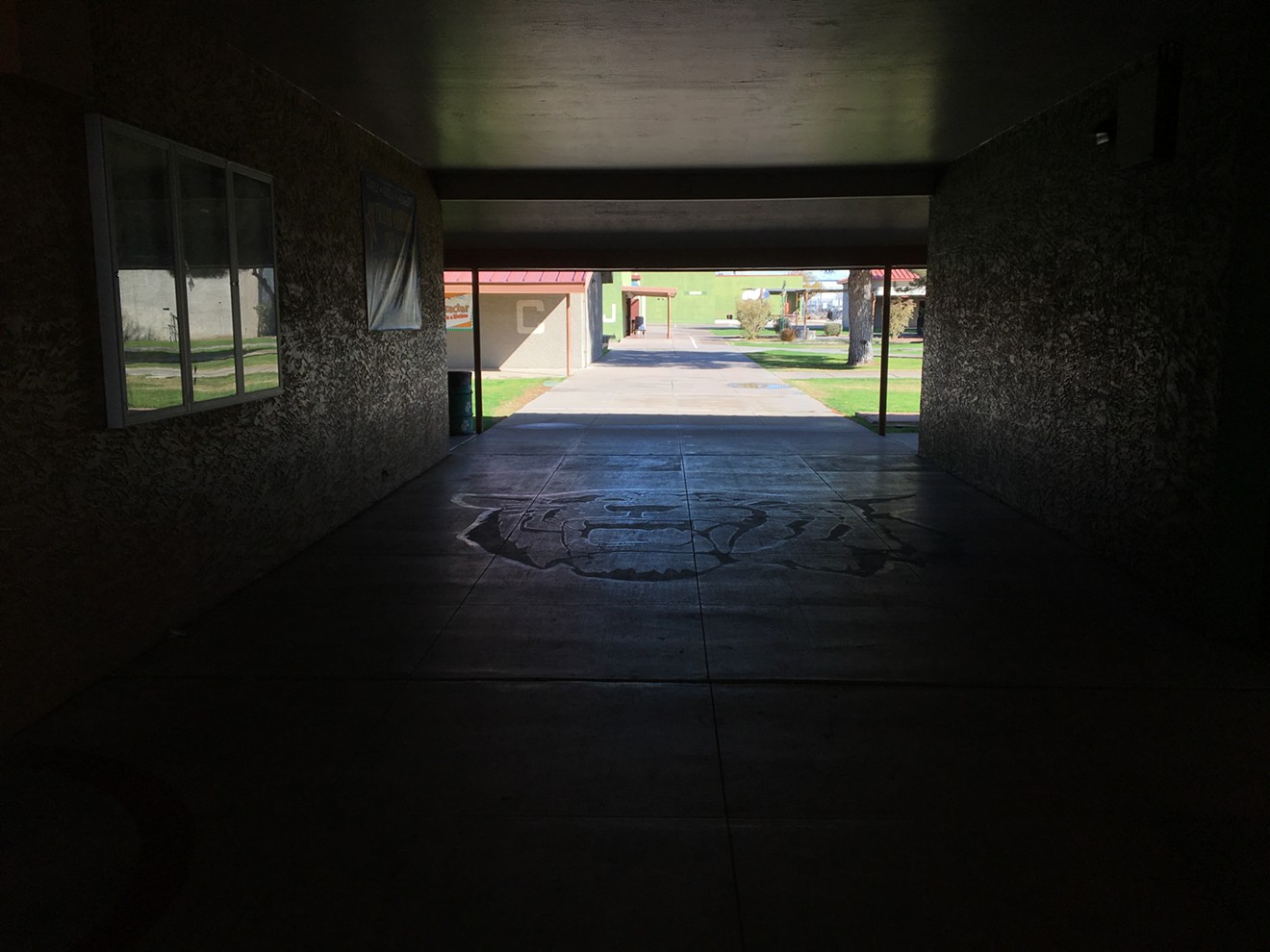During the mandatory, four-hour block of school time, ELL students are separated from their English-speaking peers. Advocates say the method leads to poor outcomes, including Arizona's exceedingly low graduation rate for ELL students.
On Tuesday, two days into the new legislative session, a committee of the Arizona Legislature moved to roll back the four-hour mandate by half, unanimously passing a Republican-sponsored bill in the Senate Education Committee. The measure also allows district and charter schools to develop more English-instruction alternatives.
Arizona's student population of more than 80,000 English-language learners end up largely segregated from their English-speaking classmates for half the day because of a restrictive law that voters approved in 2000.
For most ELL students, it means four hours in a classroom surrounded by fellow ELL students all studying English grammar, conversation, and vocabulary – no other languages allowed.
The majority of ELL students in Arizona speak Spanish. And for years, educators have sought to jettison the four-hour daily dose of English immersion. They say the teaching method contradicts research which shows the positives of bilingual education and the negative effects of a rigid, English-only method.
The immersion portion of the day takes up so much time, it takes away from learning other subjects like social studies and math. It reduces the number of hours available to students for them to take other required or elective classes, putting pressure on their timeline to graduation. And it takes students away from their peers who speak English as their first language, even though ELL students might pick up English simply by interacting with their classmates.
Bilingual education, on the other hand, allows students to rely on their Spanish language skills when learning English, advocates say, strengthening both languages at once.
At the committee meeting, bill sponsor Senator Paul Boyer said, “School is hard enough without having a language barrier. And think about the years that these kids aren’t getting content."
Because they're stuck in the four-hour block, the students are missing out on history, math, science, and other subjects that he said would be a joy to learn.
"My heart just breaks for these 85,000 kids," Boyer said. The results for ELL students don't bear out the idea that four hours of English-only instruction helps them learn, he said, citing the research that suggests negative outcomes.
A Republican from District 20 who represents north Phoenix and Glendale, Boyer works as a high school teacher in Phoenix. He sponsored a version of the bill last year, when he was a state representative and the chair of the House Education Committee.
That proposal sailed through the House with a vote of 56-1-3, and then was approved by the Senate Education Committee. However, the measure never received a vote of the full Senate.
At Tuesday's committee meeting, Boyer also raised a conservative argument for ending four hours of mandatory immersion: Arizona is a local-control state, he explained, so the Legislature doesn’t dictate curriculum, except when it comes to teaching English.
"It's my understanding that Arizona is the most prescriptive in the entire country, the way that we teach English," Boyer said.

Senator Paul Boyer, center, alongside Senator Sylvia Allen, the chair of the Education Committee. Boyer sponsored a measure to reform Arizona's restrictive English-only immersion law.
Joseph Flaherty
A successful ballot measure in 2000, Proposition 203, heavily restricted bilingual education and instead required English-immersion programs for ELL students in Arizona classrooms. The initiative allowed for a few exceptions so some students could receive a bilingual education through a parental waiver, but only if the student is already proficient in English or at least 10 years old.
Although Prop 203 didn't specifically mention a four-hour English section, subsequent legislation and rule-making instituted the hourly requirement for students in their first year of acquiring English. In 2006, Arizona legislators further refined the language-instruction regimen mandated by the ballot measure with a law creating an ELL Task Force and setting the four-hour standard, which went into effect during the 2008 academic year.
Under this system of English-language instruction established by Prop 203, students were meant to stay in the immersion program for one year at the most, after which they would take classes with English-proficient students.
However, education advocates and lawmakers say this isn't happening. Students sometimes remain in the ELL group for years, or as long as they don't pass the proficiency exam known as the Arizona English Language Learner Assessment, or AZELLA.
The new rules contained in Boyer's bill, SB 1014, would effectively roll back the four-hour rule.
If passed, the law would give more flexibility to schools so they can teach English outside of the confines of the rule. The bill directs the State Board of Education to approve English immersion models that call for cutting the four-hour mandate by half, requiring a minimum of just two hours of English per day, or 360 hours per year for K-6 students. Students in grades seven through 12 would receive 1.6 hours of English per day, or 300 hours per year.
Under the new standard, school officials could tinker with the schedule for English immersion depending on the best practices for their students. They could move most of the English instruction to the beginning of the year, for instance, in order to release newly proficient English students into classes with their peers.
The state board would also be required to adopt new research-based English instruction models; districts and charter schools could submit their own English instruction models for the board’s approval, opening the door to more experimentation.
Two representatives of the Tucson Unified School District spoke in support of the measure, saying it would provide flexibility for the district's population of ELL students.
Anna Manzano, the dual language program coordinator for TUSD, told the committee that her district currently has approximately 5,000 English language learners. "This bill would have a massive impact in our programs," she said.
More than 10 years of using the four-hour immersion classes have yielded very poor results, Manzano said, with low graduation rates and an achievement gap on the AzMERIT exam for ELL students. In 2017, NPR reported that based on data from the U.S. Department of Education, the graduation rate of Arizona's ELL students was just 18 percent – the lowest in the country. Research suggests that four hours in immersion programs each day prevents participating students from gaining the credits required to graduate on time.
"Arizona's current law has limited us to a model that is based on very little research," Manzano said. "Other language models with stronger research do exist."
Boyer's bill would not repeal the voter-approved Prop 203. But it would provide hope to people who want to see significant reform who have been stymied in the past. Last year, in spite of the wide support for Boyer's ELL bill among legislators from both caucuses, then-Senate President Steve Yarbrough refused to schedule it for a vote on the Senate floor. Last April, Yarbrough told the Arizona Capitol Times that he believes the four-hour model is working.
But now Yarbrough is gone, and there is at least one new ally in the battle to reform Arizona's English-only teaching environment: Superintendent of Public Instruction Kathy Hoffman, a speech pathologist who championed bilingual education and called for rejecting the English-only requirement during her campaign. Hoffman was present in the audience at the Senate Education Committee meeting on Tuesday.
A spokesperson for Hoffman said she supports SB 1014 and was happy to see it receive unanimous support from the committee.
As legislators cast their votes at the meeting, Senator Martín Quezada, a progressive Democrat from Maryvale and member of the Education Committee, said the next step in reforming English instruction would be to repeal Prop 203. At the same time, he acknowledged that a repeal is probably not politically realistic.
The state ultimately needs to move toward an education system that uses research-based teaching practices, Quezada said at the meeting.
"We have to move away from programs that we know are failing our kids," Quezada said.












